
|   |

|   |
Konark Dance Festival 2014 - Dr. Sunil Kothari e-mail: sunilkothari1933@gmail.com Photos: Odisha Tourism December 14, 2014 From 1st till 5th December, Konark wears a festive look. The road leading to Konark temple is ablaze with colourful lights, colourful umbrellas, lamp shades, trees glittering with creepers of lights and the sky shines with near full moon. Various large hoardings and display boards with digitalized enlarged images of dancers featured in this festival and previous years are mounted at various points on the walls of Yatri Niwas. The stage is a pucca built one with green rooms in the basement. The multi-tier seating open air theatre faces the impressive tower of Konark temple (now wrapped in wooden scaffoldings). The Khajuraho Dance Festival is held against the backdrop of Chitragupta temple on a permanent stage, but the Konark Dance Festival does not have that proximity to the temple. It is essentially organized for group dances and the large sprawling stage is ideally suited for that. This year, if I understood correctly from senior Odissi exponent Kum Kum Mohanty, it is the 25th year of Konark Dance Festival. If so, the organizers missed the celebration of its silver jubilee. The sleepy Konark village comes to life from 1st to 5th December every year since the Department of Tourism and Culture has taken over organizing the festival. The dates are fixed and well advertised, the festival has its own website, announcements are made in the print media in advance and also on television. A festive mood prevails. The traditional tunes of Odiya songs are played on mahuri, reed instruments, accompanied by the drums, and the microphones blare filmy songs. Yatri Niwas lawns are painted green and yellow. It is the focal point as participating artists are accommodated there, and the Government officials come there for tea before going to the open air theatre. The festival starts punctually at 6pm and is telecast live on DD Bharati. By evening when the sun sets, on both sides of the lane leading to the festival venue, several stalls are lined up, selling knick knacks, traditional Orissa saris, colourful umbrellas and lamp shades from Pipli village known for the handicrafts, toys, fast food, medicines, books etc. For more than a kilometre everything is ablaze with lights. People throng to the venue, coming by cars and special buses from Bhubaneswar. At Yatri Niwas, the traditional dummy horse dances are performed daily before the dance festival starts. A similar tradition called Kachhi Ghodi exists in Rajasthan. Well known compere Sadhana Srivastava from New Delhi along with Mrityunjay Rath, a professor of English literature well versed in Odiya language, introduce the program. While Sadhana is a thorough professional with an enviable track record of more than three decades, Mrityunjay Rath casts a spell with his poetic Odiya language. Over the years, a professional approach to these announcements has been developed, which is a bonus for the festival. Performances This year being the year for traditional preparations for Navakalevar, the new idols of Lord Jagannath, Subhadra and Balabhadra, the theme was aptly selected by Guru Kelucharan Mohapatra Odissi Dance Centre and University of Culture for group dances dwelling upon the story of how these idols were created. When the King out of curiosity opened the doors of the temple, against the warning that they must not be opened, the sculptor had disappeared and the idols have been since then worshipped as we see them today. There were interesting incidents like when the Yadavas get drunk and kill each other, Lord Krishna is shot by a hunter, mistaking him as deer resting under a tree, the Pandavas are called, Krishna embraces Arjuna and takes away his arts and the dead body of Krishna is set floating on waters. One did not know of this version and it was delightful to learn it. The dancers of both the institutions and the musicians worked as a team. It was heartening to see an appropriate theme was selected which had wide appeal. 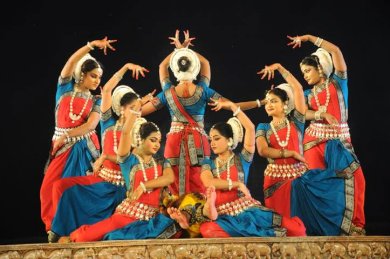 Navakalevar 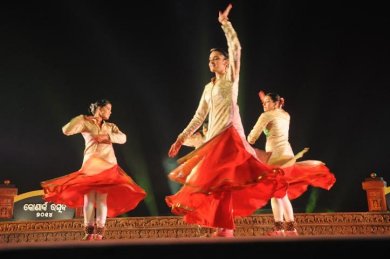 Bhavachakra Kathak dancer Shovana Narayan and her troupe chose to present Bhavachakra. Chakra stands for wheel and the dancer associated it with the chariot wheel of Konark. The cyclic existence of life, samsara, was interpreted as a division into four parts. First one was an ode to Surya, the presiding deity of Konark. The girls and boys performed spiritedly with pirouettes, suggesting also the circular movements. Sun provides energy, preservation, dispels darkness and sustains life. Though abstract in its concept, the energetic execution by the troupe engaged the attention of the audience. In Sringara, Shovana selected Amir Khusro’s compositions: Khusro baji prem ki , main khelun pi ke sang, jit gayi to jit gayi, piya aur har gayi to piya ke sang, tan mero, man mero dau bhaye ek rang - I shall play the game with my beloved, and if I win shall be with beloved and if defeated even then shall be with him. The power of the Goddess, Devi, Shakti, her dance in lasya contrasted with Tandava Ullasa, the dance of Lord Shiva, its association with shrishti (creation), sthiti (preservation), samhara (destruction), tirobhava (illusion) and anugraha (release) were epitomised in movement as eternal energy. It gave scope to the male dancers to display vigour through tatkar, footwork, an inevitable element in Kathak. It was employed imaginatively. Shovana wove in Kathak Chaturanga, four aspects of a recited verse, a sung verse, a pure rhythmic and a melodic composition. When I listened to Main nir bhari dukh ke badari (I am a cloud full of waters of unhappiness), a rather sad song of the gathering of clouds, I asked Shovana later why it started on a sad note. She explained that the anticipated joyous showers, as in the following Nabh ke nava ang bun ke dukul malin chhaya, ghanan ghanana barse megha, papiha bole piyu piyu, there was a song of expectancy of hope as in the following kavit: mera pad pad sangit bhara, sanson men parag bhara, sawan chahun aur sawan nache, chanchal man mor magan nache, chapala chit chor nayan nache, yuavan mad bhor bhuvan nache and the jhula swing song, koyal bole anguva ki dar, pankha khole harse papiha chandan van men hirani nache, was dovetailed to evoke happiness. The music created the monsoon sounds and fury. She then wove Gurudev Tagore’s popular Mama chitte song - who is dancing in my mind? Ta ta thoi thoi ta ta thoi thoi found audience singing and clapping with the dancers. On a note of happiness the group dance ended. Full of energy, the dancers succeeded in conveying an abstract concept. A team of musicians including vocalist Madho Prasad and percussionists Shakeel Ahmed Khan on tabla, Mahavir Gangani on pakhavaj and Vijay Sharma on sitar gave the dancers commendable support. Lighting by Nitin Jain highlighted the appropriate moods of the presentation. Sobha Naidu’s troupe performed in Kuchipudi, Mysore Vasudevacharya’s composition Pranamamyaham in praise of Lord Ganapati. The Sanskrit epithets Gananatha, Maniharabhushita munivara vandita (bejewelled, worshipped by the sages) and other description found felicitous expression in the execution of spirited dance by her young energetic female disciples. At one point they looked pencil thin. But all of them well groomed in Vempati Chinna Satyam’s style performed with élan and grace, followed by Sri Raja Rajeswari ashtakam, a devotional composition in praise of Parvati. The group composition, dancers standing one behind the other, created an illusion of multi-armed goddess. The ashtakam replete with several imaginative associations like Amba, Mohini, Tribhuvana Anandakandayini, venumuraligana lolini, Kalyani, Bimbavadana, Bhagavati, Nupura ratna Kankana dharini, Haravali, Venu veena vinoda vadini, Bhadrakali, Brahmani, Chamunda, Dakshayani et al gave the choreographer a field day to create sculptural images of the goddess. One recalls with delight those images with excellent lighting even after the number was over. The refrain Amba, Shula, Dhanu, Pashankushadhari, Varahi was haunting and rendered melodiously with typical lilt found in Kuchipudi. Described as ‘Pada kavita Pitamaha’ poet Annamacharya’s composition Deva Devam Bhaje saw dancers enacting noble deeds of Lord Rama. Shivadhanurbhangam and Rama Ravana yuddham provided the choreographer enough scope for depicting most familiar episodes from Ramayana. Exploiting the dynamic movements and intricate footwork the number had the charming touch of Kuchipudi as envisioned by Vempati. The performance ended with the popular Swagatam Krishna, sharanagatam Krishna. With lilting stanzas from Krishna Leela Tarangini, Madurapurisadana, mriduvadana, Madhusudana, Gopagopijana, Gokulapurnachandra gopam bhaje it cast a spell on the audience. In sancharis, the imaginative inclusion of Dashavatara enriched the choreography. The swing and allure, the gait, the enchanting movements, the hallmarks of Kuchipudi were in full force. The concluding Ramadasu kirtana with Rajivalochana, lotus eyed, pankajapada narayana verses was replete with devotional fervour. As a prime disciple of Vempati Chinna Satyam, Sobha Naidu has contributed immensely to make the dance form popular. Settled in Hyderabad, she has been training a young generation of dancers with enthusiasm. It was heartening to learn that she is grooming her niece Sagarika in Kuchipudi. Though Sobha Naidu does not perform now, whatever she transmits to her disciples is scintillating and in keeping with her guru’s tradition. 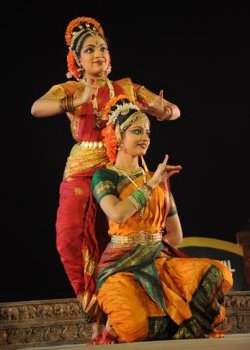 Sobha Naidu’s troupe 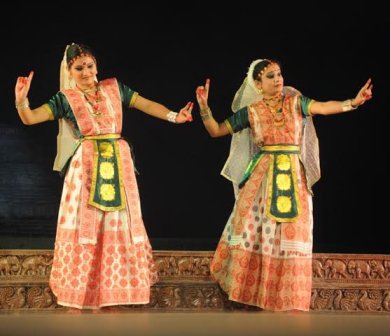 Sattriya dance As I was indisposed, I missed Guru Ghanakanta Bora Barbayan’s Sattriya dance presentation. My loss. But I gather from other confreres and my colleagues that their presentation was of a high aesthetic standard for which Guru Ghanakanta is well known. I caught up with Gotipua dancers’ high energy, rustic charm. In the morning, I had visited Konark Natya Mandap, late Guru Gangadhar Pradhan’s institution, which he had established in 1986. The Gotipua boys are given training in dance from the young age of seven. I was keen to meet octogenarian legendary Guru Birbar Sahoo. But he is not in good health and was staying with his son in Bhubaneswar. Six of the senior performers who were to dance that evening were down with chicken pox. Since there are many Gotipua boys at the institute, they managed. Young Gotipua boys have cherubic charm and the audience is inevitably drawn to them. Their acrobatic bandhas are so popular that even if one has seen them many times, the impact they create is fascinating. Acrobatics and art in Gotipuas’dancing merge in a seamless manner. Their pliable limbs take any shape - split, falling on floor with ease, raising their legs and bringing them in front through which their face is seen and they walk like mythical animals or chala mayura, walking peacock. Walking on two hands, palms on the floor and legs turned upwards, body in an arch gives an illusion of a peacock moving. A myriad of bandhas, forming pyramids, youngest one climbs on the bodies of other gotipua dancers, and holds pose like Lord Shiva or say Krishna holding the flute. And then in a trice jumping down without any fear, they enchant the audiences wherever they perform. Besides the bandhas (bodily formulations), they also perform to traditional songs. When I entered the auditorium they were dancing to Dekho go sakhi dekho go Radha Madhav. I am very fond of these traditional songs with their enchanting tunes. My favourite is of course To laagi Gopa danda mana re kaliya suna made famous by Guru Kelucharan Mohapatra. These songs are part of one’s being in Odisha. One grows up listening to them. The typical Odissi music is also preserved in Gotipua repertoire of songs. Of late there is a tendency to choreograph patriotic songs and songs depicting agricultural activities. This is also inevitable as elements of such themes attract young performers. And dance being a dynamic art form, will admit changes. It will be pertinent to mention that when I participated in Stirring Odissi, a month long festival of Odissi dance organized by Ramli Ibrahim in Kuala Lumpur a few years ago, I presented the Gotipua dance repertoire screening documented material, besides my favourite To laagi Gopa danda song which I had asked Arushi Mudgal to perform to show how from Gotipua tradition, under guidance of Guru Kelucharan Mohapatra, it had morphed into a beautiful abhinaya pada in classical Odissi format. After showing traditional Gotipua dancers performing it before the idols near a monastery in Puri, and how Arushi performed, the screening of other Gotipua dancers suddenly displayed a patriotic song including waving of our national flag! Though it did strike a discordant note, it was obvious that Gotipua dancers were choreographing such numbers to cater to popular taste. 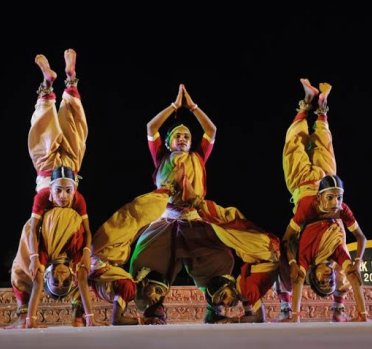 Gotipuas of Konark Natya Mandap 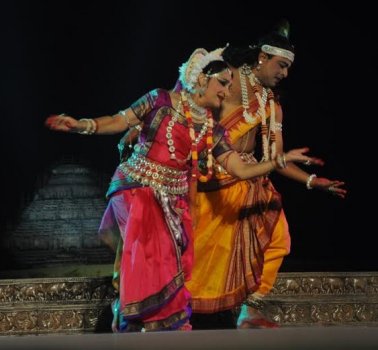 Ranjana Gauhar’s troupe Ranjana Gauhar is a name to reckon with in Odissi. Hailed for her researches in Odissi and preparing documentary films on Odissi dance, its origins and historical developments, her own solo performances and dance dramas, group choreographic works including use of the Chhau dance form, has won considerable reputation. Therefore, one was looking forward to her presentation of Gita Goivinda as a dance drama with her well trained dancers. In spite of melodious music, easy to follow narrative, some striking visuals, the dance drama left much to be desired. The abhinaya was melodramatic. Both Radha and Krishna were reduced to mortal beings seen in a popular play. Their overacting looked incongruent, far removed from the noble and subtle feelings it was expected to evoke. When Krishna does not turn up to meet Radha at the appointed hour, and when he turns up with telltale marks on his body, having spent night with other gopis, Radha’s asking him to leave in Yahi Keshava, Krishna’s begging her forgiveness in Priye Charushile etc., were enacted in such loud manner that to watch that sort of abhinaya one felt very sad. One only wondered what made Ranjana choreograph this classic in such manner. Ashok Ghoshal as Krishna appeared pathetic while running hither and thither at Radha’s accusations that it bordered on display of emotions one would associate in the enactment of Jatra, but inappropriate for a classic like Gita Govinda. The choreography of Gita Govinda minus its subtlety and ennobling impact created an uncomfortable response. In complete contrast, the next day one watched with great relief guru V.P. Dhananjayan and Shanta’s Bharatanatyam production of Shakti Pravaham. They lived up to their reputation as serious artists, following high aesthetic approach and revealing the inherent beauty of Bharatanatyam. Whether it was the opening number Deepanjali based on Bankim Chandra’s patriotic song ‘Vande Mataram’, or Nritta Swaravali, pure rhythmic choreographic work based on ancient text of Bharatarnava, their presentation looked neat and highly dignified. The main choreographic work Shakti Pravaham was based upon Kavi Subramania Bharati’s work Parashakti. The program note mentions in the brochure: ‘The primordial women power is symbolized as Saraswati (knowledge), Lakshmi (wealth), and Durga (life). Prakriti, nature, as the combined power of five elements, panchabuta, water, earth, wind, fire and ether is again symbolized as Parashakti, who is three in one aspect of creation. Divided as knowledge, wealth and life on earth symbolised as Parvati. We draw all knowledge from nature, wealth from earth, love and life from the concept of Shiva and Parvati.’ Though abstract in concept and with philosophic overtones, the abstraction with figures of Saraswati, Lakshmi and Durga were well etched out and the dancers staged tableaux in two directions towards the back of the stage. With emergence of Saraswati, Lakshmi and Durga, with the centripetal choreography, the group making a canopy over the emerging goddess was a clever ploy. Once the narrative was staged, the concept was easy to grasp. The troupe ended with Nritta Tarangam which wove geometrical patterns of lines, circles, triangles and squares which had lot of visual appeal. So what set Dhananjayan’s troupe apart from the others? There was uniform Bharatanatyam technique, the costumes designed by Katherine Kunhiraman were simple, the music conducted by Shanta complimented the dance, the dance technique had a flawless neatness and overall harmony. Since both Dhananjayan and Shanta are Kalakshetra products, the high values of Kalakshetra are deeply embedded in them. Whatever they do, it has cleanliness, uncluttered movements and harmonious working which makes sense to one and all. Kalakshetra is one institution which has groomed a generation of dancers, who inculcate those values in their disciples. The technique has to be sound, the meaning of the text be it in Telugu, Tamil, Malayalam or Sanskrit has to be understood for better projection, the music has to be mastered as it is the soul of dance. The costumes have to be elegant with good taste for colours and texture. Their students are well versed in these aspects. Therefore the entire presentation leaves an indelible impression. Of all the presentations I witnessed, theirs was the most satisfying and enjoyable. 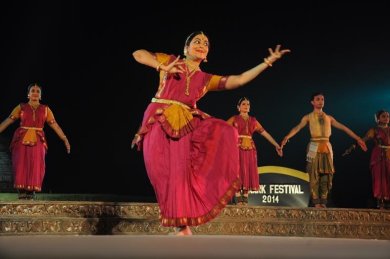 Dhananjayans’ group 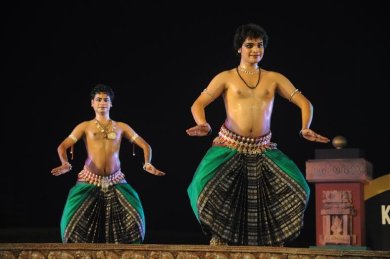 Durga Charan Ranbir’s group Before coming to Konark from Bhubaneswar, I went to see the rehearsal of ‘Jagannath Gopinath’ choreographic work of Guru Durga Charan Ranbir, which he was to present on the last day. His Nrutyayan has a commendable group of both male and female dancers. The Skanda and Brahma Puranas have attributed the creation of the idols of Lord Jagannatha during the reign of a pious King Indradyumna. Coming as full circle what began with Navakaleva dance drama as an opening, the finale had similar story in which Jagannatha Gopinatha parallel is drawn between the pastimes of Krishna in Dwapara Yuga and the rituals of Jagannath in Puri. Kamsa brings his sister Devaki and her husband Vasudeva after their marriage in a chariot, when Kamsa hears the akashavani that his sister’s eighth child would kill him. Enraged at this he got off from the chariot and threw Devaki and Vasudeva into jail. Guru Durga Charan Ranbir is known for his flair for choreography. He created the chariot, horses, the driving of the chariot, and almost an illusion of Devaki and Vasudeva being driven in it. In another sequence when all are asleep, the doors of the jail open, water of Yamuna recedes, Sheshanaga arrives and holds its hood over Krishna whom Vasudeva takes in a basket keeping him on his head and proceeding to Gokul. Durga Charan’s choreography is spectacular. I am glad I saw the rehearsal, as I had to leave on last day for Singapore. 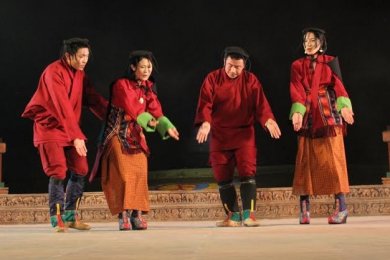 Bhutanese dance 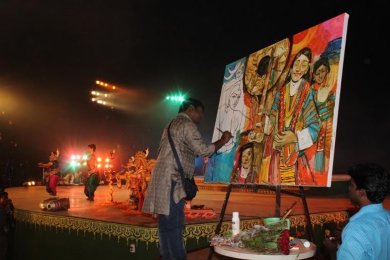 Painting The inclusion of Bhutanese dances in the festival augurs well for the festival. In the past I have seen Balinese Ramayana being staged at Konark Festival. If sufficient notice is given by international troupes visiting India in December, Indian Council for Cultural Relations (ICCR) can inform the Secretary, Dept of Tourism and Culture, to include one of the troupes from abroad. I must say the photos of dancers are carried very next day both in Odiya and English newspapers if not the reviews. The best part of such festivals has been when the dancers, their accompanying musicians, the critics and press reporters are given accommodation in Yatri Niwas, so the meetings over dinner, breakfast and lunch provide an opportunity to know each other better, discuss the performances, receive good feedback and an atmosphere of bonhomie and goodwill is generated. Few suggestions for consideration It is not practice in India to have a Director of the festival with a small staff who plans in advance the selection of artists having seen their work, even visiting their towns, watching rehearsals and finalising them for performances. Even if the work is in progress, the Director can commission the work for the festival. The general practice is to have a local committee of established dancers from within Odisha, most probably from Bhubaneswar, who would recommend the artists on the basis of their reputation and prominence. It is therefore likely that some may err on selection of renowned artists not having seen their recent works. If months in advance artists are selected and given the guidelines, it is possible to have a streamlined festival. In the selection committee one of the renowned critics who has been to various festivals within India and abroad and who regularly watches performances in the city, can be invited as a member of the selection committee and it is possible to select the best troupes. The process has to be transparent and aim to keep the standards very high. The artists should provide the exact synopsis of the program visualized with right photographs for the souvenir brought out on the occasion, with complete credits. It should be modestly priced so people take it home as a souvenir. A special editor can be appointed to edit the material sent by the dance troupes. Abroad this is done professionally. It can be done also for such annual festivals. The program books distributed free at present are of course well designed but they lack focus, have no appropriate photos highlighting the performances to take place. It is a question of working towards the goal and providing best material, if necessary at modest price. I found that local dance critics were not invited offering them transport as they have to come from Bhubaneswar. Asking them to come daily by public transport provided by Tourism Dept is not an alternative. The established critics/reporters from Bhubaneswar must be given the facilities to arrive and depart by car comfortably. The telecast of live program is indeed a welcome step. However, if the cameramen and director who is in charge of the recording and telecasting are not well versed to record the dancing, the telecasting becomes often a disaster in terms of correct angles and expressions. A case in point is the close-ups of the dancers and backdrop of artificial architectural sets as mounted in Khajuraho. These are awful in terms of close-ups. Worst have been recordings of performances and none seems to be bothered about it. These matters deserve special attention. Dr. Arabinda K Padhi, the new Commissioner-cum-Secretary of the Department of Tourism and Culture, Govt of Odisha has shown excellent organizational approach, with important dignitaries, including the Maharaja of Puri attending the dance festival and creating awareness among those who matter and can help the festival grow. Continuing the work of former secretary in charge Mr. Ashok Tripathy, Dr. Padhi has carefully kept many programs initiated by his predecessor. I look forward to receiving feedback from him for these suggestions. 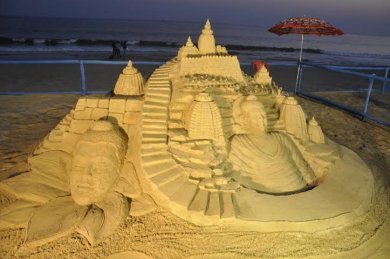

This year sand artists from abroad had arrived well in advance to participate. Besides the sand sculpture of Navakalevar, there were themes of awareness of Aids and physically challenged. The artists were provided all facilities for creating their sand art. The colourful umbrellas and chairs were placed on the beach, posters were displayed, the Padma Shri awardee Odiya artist Sudarshan Pattnaik’s participation in Spain, USA and other European countries was displayed near the enclosures on the beach. I saw on DD Bharati, an interview with sand artists who threw lot of light on different types of sands in different countries and how sand sculptures were made. When I went to see morning sunrise, I saw a large crowd witnessing the sunrise and then moving towards the rows of sand sculptures. The entire atmosphere was joyous. Odiya Jatra Around midnight a popular Jatra party stages Jatra for five nights. That crowd is entirely different, but fills the enclosure paying ticket rates up to Rs 500 and the shows are sold out. It was fascinating to watch. Before the show starts, the microphones blare with Anup Jalota’s songs of Meera, Hanuman Chalisa, Tulasi Ramayana. And when the show begins, the prayer Jagannatha swami nayan patha gami bhavatu me is performed by actors imitating Odissi dance. Then appear bow tie clad ‘suited booted’ chap holding mike in his hand with mile long wire and he speaks in corrupt Hindi and mix of Urdu, something about the beauty of husna, pari, about scantily dressed women, also holding mike in hand and responding to the man, coming close to the enclosure of the arena where they perform, and the audience shouts lewd remarks to which the female blows kisses. There were several songs from films, acrobatic feats and it looked to me endless divertissement before the main play started. Enough was enough for me, having tasted the flavour of popular entertainment along with classical dance festival, and I walked away silently to Yatri Niwas. The near full moon shone brilliantly in the sky. The month of December with nip in the air was indeed the right time for the five day festival.  Dr. Sunil Kothari is a dance historian, scholar, author and a renowned dance critic. He is Vice President of World Dance Alliance Asia Pacific India chapter, based in New Delhi. He is honored by the President of India with Padma Shri, Sangeet Natak Akademi award and Senior Critic Award from Dance Critics Association, NYC. He is a regular contributor to www.narthaki.com, the roving critic for monthly magazine Sruti and is a contributing editor of Nartanam for the past 12 years. Response * It has taken me some time to read and absorb your excellent review of the Konark Dance Festival 2014. The writing is like an archetype of what should be included in a complete review. Setting the physical scene, the social ambiance, the performances and the historical contexts are essential elements, as you demonstrated in your review. Thank goodness for Narthaki, where room is given to say something of substance, instead of a 200-word clip. - Janaki Patrik (Jan 8, 2015) Post your comments Pl provide your name and email id along with your comment. All appropriate comments posted with name and email id in the blog will also be featured in the site. |